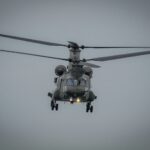Ukrainian Navy personnel ran the opposing force during the REPMUS and Dynamic Messenger 2025 series off Tróia and Sesimbra through September, a first for the alliance-level unmanned maritime trials. The host navy concentrated the event at the Portuguese Navy’s Operational Experimentation Centre, with live serials at sea and daily range windows ashore. Official schedules placed REPMUS from Sept. 1 to 26.
Exercise leads split participants into red and blue cells for structured mission problems. Ukraine held the red cell lead across multiple vignettes and coordinated its own uncrewed assets inside those packages. NATO messaging described the step as historic and tied to the practical need to test against tactics sourced from real combat.
Portuguese officers confirmed that Ukrainian unmanned surface vessels joined the package. The host service declined to publish platform-by-platform details on security grounds. A press briefing at the centre in Tróia emphasized the goal of extracting tactics and countertactics.
Daily electronic warfare windows hit the script. Range control ran jamming trials every afternoon from 5 to 6 p.m., stressing command links and autonomy stacks on participating drones. The timetable repeated across the exercise to give each serial a comparable stress profile. Defense officials confirm that the window covered both red and blue assets.
A REPMUS slide deck listed the red cell with 61 drones in total, including 57 unmanned surface vessels and a single unmanned ground vehicle.
Ukrainian Navy OPFOR Role at REPMUS 2025 in Tróia, Portugal
The Portuguese-led package combined the experimentation-focused REPMUS with NATO’s Dynamic Messenger operational serials. Allied Maritime Command and national hosts used the larger event to fold new autonomy, networking, and data tools into ship routines. Allied releases cite 22 allied nations with 13 observing states present across the two linked activities. Trade reporting counted roughly 276 uncrewed systems and close to 3,700 participants on the water and ashore.
U.S. Sixth Fleet elements demonstrated counter-swarm responses near the Tróia ranges. Task Force 66 used three Global Autonomous Reconnaissance Craft to disrupt a simulated massed USV attack aiming at critical infrastructure. The scenario ran in sight of the experimentation centre and paired U.S. craft with European partner vessels under a single vignette director.
Commanders framed the two-part design as deliberate. REPMUS provided the sandbox for capability maturation and interoperability checks. Dynamic Messenger carried those candidate tools into controlled operational play with frigates, mine warfare teams, and seabed surveillance assets. Allied communiqués pointed to digital transformation goals, with emphasis on data management and command-and-control integration inside normal fleet processes.
NATO’s innovation arm also used the event to put startup hardware aboard fleet units. DIANA participant companies integrated their systems with the modernised M-class frigate D. Francisco de Almeida and the survey ship D. Carlos I. One team installed point-to-point laser communications terminals on both hulls and recorded multiple successful links during the trials.
According to industry sources, several allied labs exploited the fixed jamming hour to measure link resilience and handoff behavior under controlled interference. The single-hour block simplified comparison across platforms without telegraphing specific counter-EW methods.
Magura V7.2 Presence and Performance
Imagery from the Tróia pier showed a Magura V7-series drone boat moored near the experimentation centre during the week of Sept. 23. The manufacturer declined public comment on the platform’s participation. Ukrainian defense media described a refreshed V7.2 variant on site and outlined hull and exhaust changes, a launcher relocation toward mid-deck, and updates to navigation and guidance.
Ukrainian sources place the V7 family at roughly 3,400 kilograms in this configuration, with an advertised range figure up to 1,500 kilometers. Earlier white-paper claims tied the smaller V5 to combat footage against Russian naval targets, and separate open-source reporting through late September chronicled Magura drift and recovery events far from the Black Sea, which underlines endurance and navigation performance in heavy traffic zones.
Open imagery also captured a V7.2 air-defense fit using repurposed man-portable air-to-air missiles on a light mount. Ukrainian media paired those photos with notes on the revised mast, optics placement, and radar fit options across the sub-variants. Public posts from Portuguese defense observers marked the dates and location at CEOM. Defense officials confirm that visiting national teams brought their own safety and handling crews for any platform parked at the pier.
Analysts follow the Magura line closely because it links industrial improvisation to wartime feedback. Profiles catalogued through the summer and early autumn tracked successive V6 and V7 tweaks and mapped how launchers, masts, and sensor housings moved to handle sea-state, thermal signature, and stability constraints. The Portugal appearance gave allied operators a close-in view of those choices.
According to industry sources, trial directors kept the Magura hulls on short test cards near the ranges and avoided disclosure of detailed navigation tracks. That posture matches normal REPMUS practice for third-party hardware and preserved the neutral, instrumented environment across all teams.
Portuguese Navy X31 Unit and Trator do Mar Trials
The Portuguese Navy stood up unit X31 on Feb. 9, 2024, as a squadron-sized formation under naval command with a remit across air, surface, and subsurface unmanned systems. X31 fields specialist teams aboard fleet units and coordinates doctrine and training for national use of drones at sea. The service has publicized X31 detachments operating from ships during patrols along the coast.
X31 collaborates with the Unmanned Vehicles Operational Experimentation Cell, known by the Portuguese acronym CEOV. CEOV developed the Trator do Mar uncrewed surface vessel as a modular testbed. The USV supports grid-pattern seabed survey with a towed array and can accept different payloads for maritime domain awareness tasks. The craft appeared at REPMUS displays and remains in the test and evaluation phase.
Portuguese documentation and specialist press trace the Trator do Mar’s progression from concept to range events across the 2024-2025 window. Photos from national days and navy technical notes show incremental outfitting on the hull and the conversion of small workboats inside CEOV to serve as additional unmanned test platforms.
Defense officials confirm that the host navy used the home-field units to knit visiting systems into the range rhythm. X31 detachments and CEOV staff handled platform deconfliction, safety corridors, and data capture. The hosts also provided liaison engineers to help partners log link performance and mission data in the daily windows.
Electronic Warfare Trial Windows and Daily Serials
The fixed 5 to 6 p.m. interference block created a common yardstick for autonomy stacks and control links across dozens of systems in the water. Range control recorded telemetry on link dropouts, handovers, reacquisition times and navigation drift while ships carried on scripted tasks. That structure maintained a clean dataset over the course of three weeks.
REPMUS organizers reported 24 national participants within the experimentation portion and scheduled observers and partners under the broader banner with Dynamic Messenger. Allied sponsors described the combined activity as a live operational setting for uncrewed system integration, with clear divisions between capability maturation and operational play.
U.S. materials emphasized the protection of critical undersea infrastructure and the management of counter-USV problems. The live demonstration near Tróia placed a defending package against a simulated swarm that targeted ports and seabed routes. The sequence tested response timing, human-on-the-loop controls and the balance between onboard autonomy and remote operator input.
Allied innovation teams added data fusion layers to accelerate evaluation. DIANA participants disclosed laser communications tests aboard a frigate and a survey ship, citing low observability and resistance to jamming during link checks.
A U.S. Navy information warfare team described command of Portuguese-range USVs from operators in Italy as part of an ongoing “Vesuvius” spiral test series, pointing to cross-border command and control options for future coalition tasks.
Ukraine’s fleet experience under fire influenced the red-cell playbook used in Portugal. Allied commentary linked the decision to put Ukraine in the lead to the need for threat-realistic scripts. The red-cell lead and the fixed jamming hour together produced a cleaner dataset for future tactic and countermeasure development across navies.
REFERENCE SOURCES
- https://www.defensenews.com/global/europe/2025/09/25/ukraine-navy-a-battle-tested-force-plays-enemy-in-nato-drone-drill/
- https://mc.nato.int/media-centre/news/2025/nato-advances-maritime-innovation-and-readiness-through-exercise-dynamic-messenger-2025
- https://navyleaders.com/news/repmus-2025-and-dynamic-messenger-taking-giant-strides-towards-nato-interoperability/
- https://www.navy.mil/DesktopModules/ArticleCS/Print.aspx?Article=4315724&ModuleId=3760&PortalId=1
- https://www.janes.com/osint-insights/defence-news/air/repmus-2025-nato-diana-participants-integrate-technologies-with-portuguese-navy-frigate
- https://eda.europa.eu/news-and-events/news/2025/09/25/eda-nato-enable-real-world-testing-of-unmanned-systems
- https://militarnyi.com/uk/news/magura-v7-modernizuvaly-ta-vyprobuyut-v-portugaliyi/
- https://united24media.com/latest-news/ukraine-tests-modernized-magura-v72-naval-drone-during-nato-trials-in-portugal-11877
- https://defence-blog.com/ukrainian-naval-drones-spotted-in-portugal/
- https://www.instagram.com/defence360/p/DPFBwBjjL67/
- https://www.hisutton.com/Ukrainian-USVs-Russo-Ukraine-War.html
- https://news.north.io/en/repmus-2025
- https://www.janes.com/osint-insights/defence-news/c4isr/repmus-2024-portuguese-navy-unveils-trator-do-mar-usv
- https://euro-sd.com/2025/03/articles/43365/from-lab-to-ship-portuguese-navy-charts-course-towards-integrated-mus-operations/
- https://www.niwcatlantic.navy.mil/Media/Article/4212775/naval-engineers-control-unmanned-vessels-across-countries-from-mission-operatio/
- https://www.bairdmaritime.com/security/naval/unmanned-naval-systems/nato-completes-unmanned-systems-exercise-in-portugal



